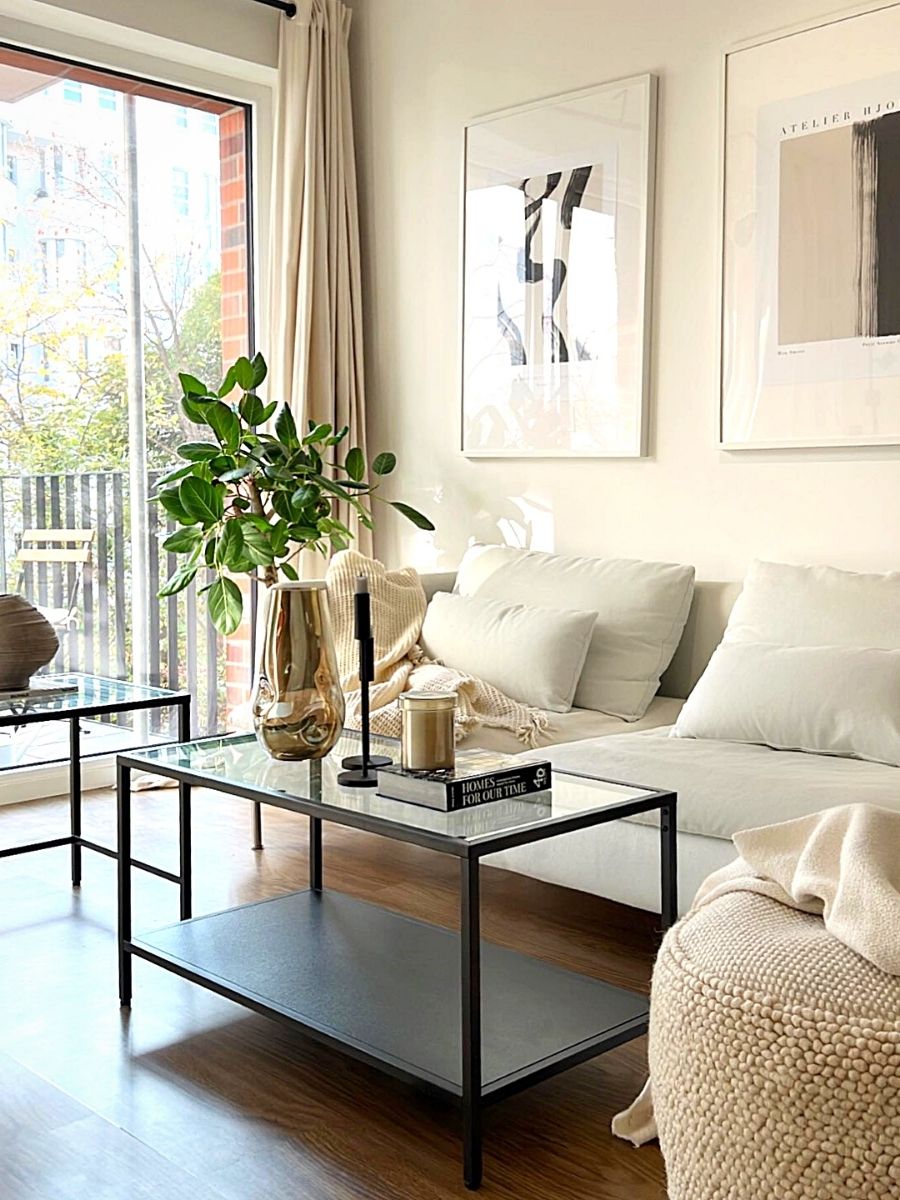
Sun Apr 06 - Written by: Ruth
Japandi Houseplant Ideas for a Serene Home
Imagine stepping into a home where calmness and simplicity greet you at the door. That's the magic of Japandi, a design trend that marries the elegance of Japanese minimalism with the warmth of Scandinavian style. We all crave a serene sanctuary away from the hustle and bustle, and incorporating houseplants can be the perfect touch to achieve that tranquil vibe.
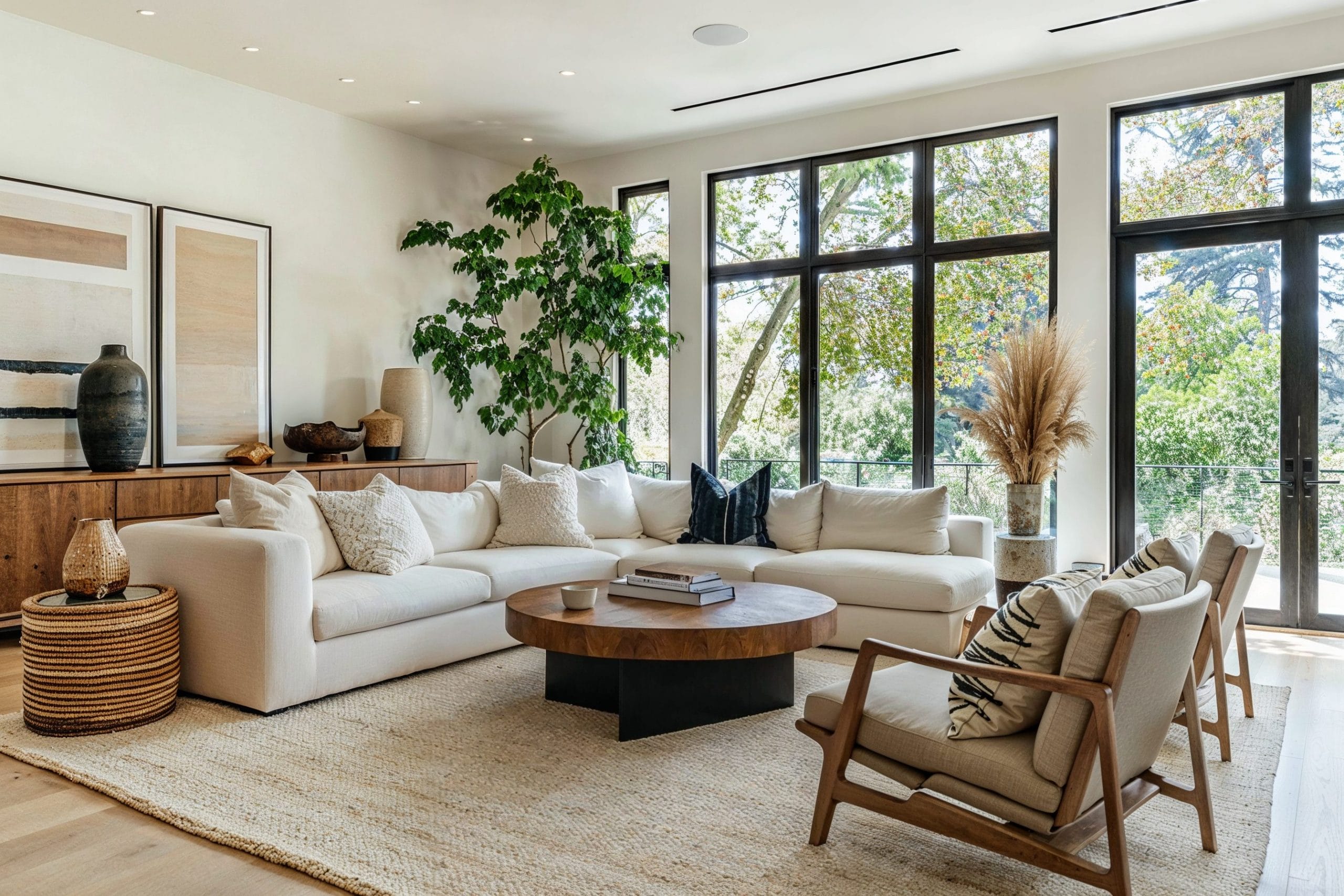 A serene Japandi-style living space incorporating houseplants for a balanced, tranquil atmosphere. Source: Decorilla
A serene Japandi-style living space incorporating houseplants for a balanced, tranquil atmosphere. Source: Decorilla
Houseplants not only purify the air but also bring a sense of peace and natural beauty to our living spaces. Whether you’re a seasoned plant parent or just starting out, we’ve got some Japandi-inspired houseplant ideas that will transform your home into a serene oasis. Let’s explore how these green companions can enhance our interiors and create that much-needed Zen atmosphere.
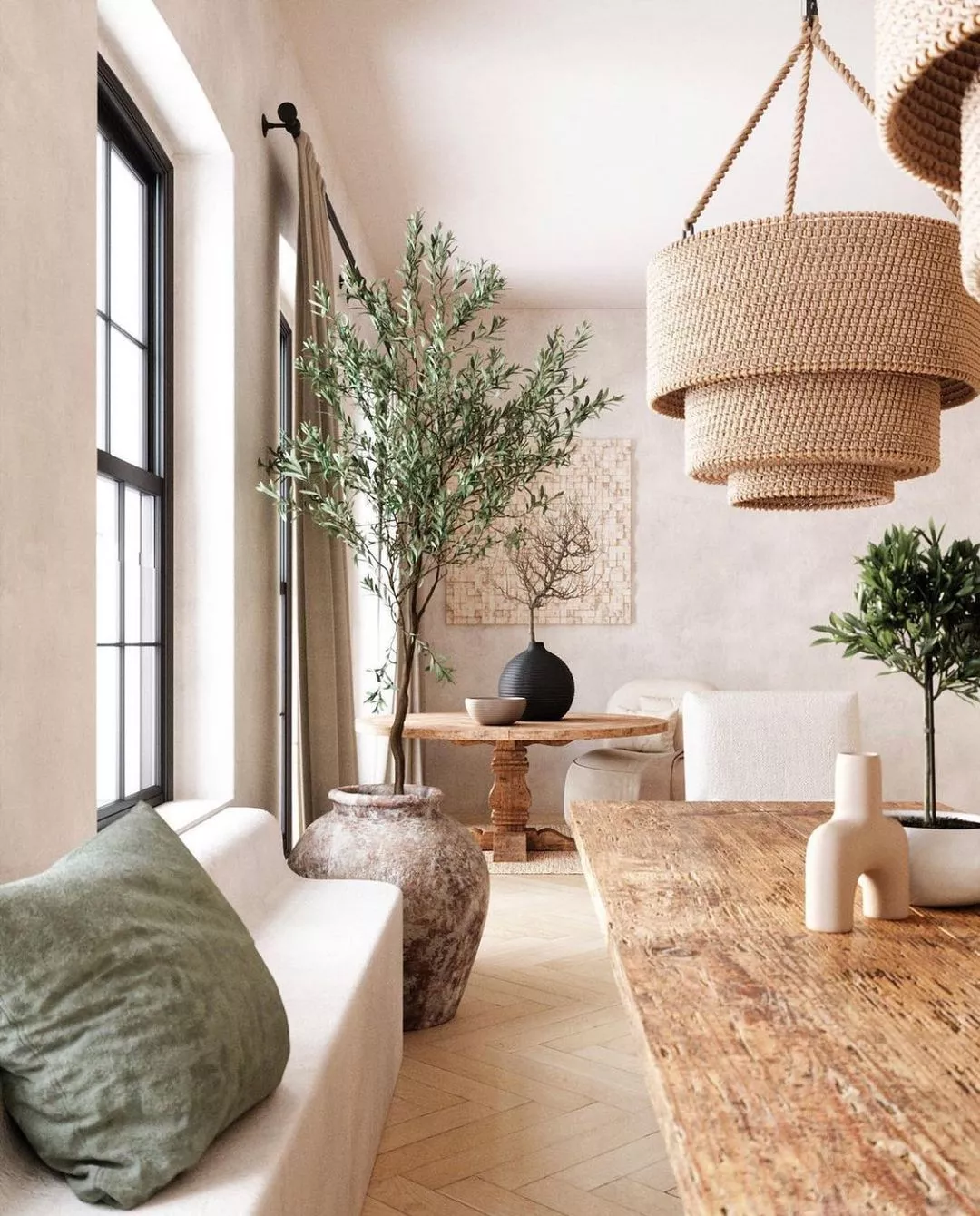 The Japandi style beautifully incorporates plants to bring life to minimalist spaces with neutral tones. Source: Extra Space Storage
The Japandi style beautifully incorporates plants to bring life to minimalist spaces with neutral tones. Source: Extra Space Storage
Fiddle Leaf Fig
The Fiddle Leaf Fig stands out with its large, glossy leaves, adding a bold yet soothing element to any Japandi-style home. As a focal point plant, it contributes significantly to the serene ambiance we aim to achieve.
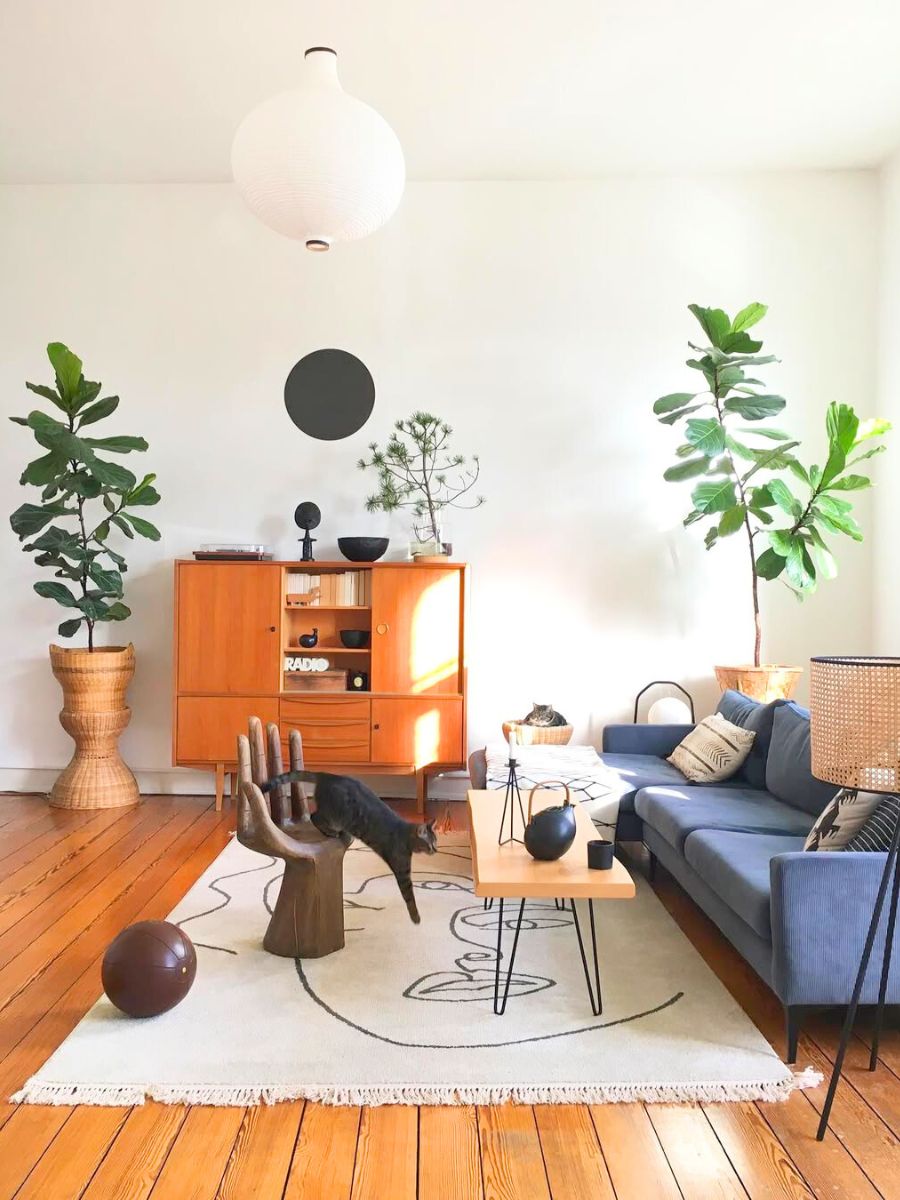 A Fiddle Leaf Fig creates a striking focal point in this Japandi-style interior with its large, sculptural leaves. Source: Thursd
A Fiddle Leaf Fig creates a striking focal point in this Japandi-style interior with its large, sculptural leaves. Source: Thursd
Care Instructions
The Fiddle Leaf Fig thrives in bright, indirect light. Direct sunlight can scorch the leaves, so it’s important to position it accordingly. Watering needs to be moderate: the soil should be allowed to dry out between waterings. Overwatering can lead to root rot. Maintain humidity around the plant by misting it occasionally. Monthly fertilization during the growing season (spring and summer) supports healthy growth. Dust the leaves occasionally to keep them looking their best and to optimize photosynthesis.
Placement Tips
Choose a spot with ample natural light but avoid direct sun exposure. Ideal locations include near east or west-facing windows. The Fiddle Leaf Fig can grow tall, making it perfect for filling vertical space in corners or next to furniture. Ensure there’s enough room for it to expand. Consider placing it in a statement pot to enhance its visual appeal. Rotating the plant occasionally ensures even growth and keeps all sides exposed to light.
Snake Plant
Snake Plant, also called Sansevieria, fits perfectly in Japandi designs with its striking vertical leaves and minimalist charm. It’s incredibly easy to maintain.
 The sharp, architectural lines of Snake Plants make them perfect companions for Japandi interiors. Source: Hortology
The sharp, architectural lines of Snake Plants make them perfect companions for Japandi interiors. Source: Hortology
Care Instructions
Snake Plants require minimal care. Water them every 2-3 weeks, ensuring the soil dries out between waterings. Overwatering can lead to root rot, so use well-draining soil to prevent waterlogging. These plants thrive in indirect light but can tolerate low light, making them versatile for various home settings.
Placement Tips
Position Snake Plants in areas needing a vertical accent or greenery. Place them in living rooms or bedrooms where they can add calmness without demanding attention. They’re also great for bathrooms due to their low light tolerance and air-purifying qualities, enhancing even smaller spaces in your Japandi-inspired home.
ZZ Plant
ZZ Plants offer a touch of glossy, dark green foliage and thrive effortlessly in minimal light conditions, making them perfect for Japandi-inspired homes.
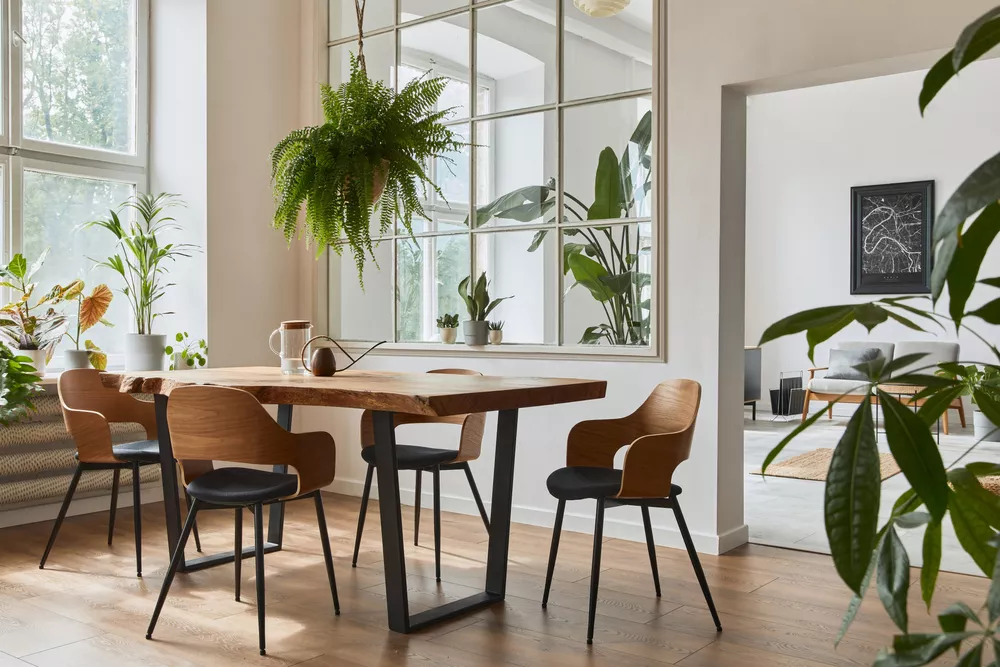 The glossy leaves of the ZZ Plant bring a subtle elegance to minimalist interiors while requiring little maintenance. Source: Extra Space Storage
The glossy leaves of the ZZ Plant bring a subtle elegance to minimalist interiors while requiring little maintenance. Source: Extra Space Storage
Care Instructions
ZZ Plants demand minimal effort, suiting busy lifestyles. Water every 2-3 weeks when the topsoil feels dry. Use well-draining soil to prevent waterlogging. Place the plant in indirect light; it tolerates low light but grows better in moderate indirect light. Avoid direct sunlight, as it can scorch the leaves. Wipe leaves occasionally to remove dust and maintain the plants shiny appearance. Fertilize every 6 months with a balanced liquid fertilizer for optimal growth.
Placement Tips
Place ZZ Plants in low-light areas like hallways and bathrooms; they thrive with little natural light. They make excellent corner accents in living rooms, adding to the tranquil Japandi ambiance. Consider placing one on a bedside table for a serene bedroom vibe. Avoid areas with direct sunlight to prevent leaf burn. Ideal locations should offer a balance of aesthetic appeal and practical care conditions. Their shiny leaves add elegance and a touch of greenery to any Japandi space.
Monstera Deliciosa
Monstera Deliciosa, often called the Swiss Cheese Plant, combines bold, perforated leaves with easy maintenance, making it perfect for Japandi-inspired homes.
 The distinctive split leaves of a Monstera add natural sculpture and visual interest to this Japandi living space. Source: Thursd
The distinctive split leaves of a Monstera add natural sculpture and visual interest to this Japandi living space. Source: Thursd
Care Instructions
Monstera Deliciosa thrives with moderate care. Water the plant when the top inch of soil feels dry, typically every 1-2 weeks. Use well-draining soil with a mix of peat moss and perlite to ensure roots aren’t waterlogged. Place the plant in bright, indirect light; direct sunlight can scorch its leaves. To maintain humidity, mist the leaves occasionally, especially in drier environments. Fertilize monthly during the growing season (spring and summer) with a balanced liquid fertilizer. Prune yellowing leaves to promote new growth and maintain the plant’s appearance. Wipe the leaves with a damp cloth every few weeks to remove dust and keep them glossy.
Placement Tips
Monstera Deliciosa adds a dramatic touch with its large, split leaves. Place it in living rooms as a statement piece near windows with filtered light. Tall plants fit well in empty corners, creating a lush backdrop while maintaining the minimalist Japandi aesthetic. Smaller Monstera plants can enhance shelves or side tables, bringing greenery into smaller spaces. Avoid placing the plant in direct paths of air conditioning or heating vents to prevent stress on the foliage. In larger rooms, let the Monstera climb by supporting it with a moss pole or trellis, adding both height and texture to your space.
Bird of Paradise
The Bird of Paradise, known for its vibrant flowers and lush foliage, is perfect for Japandi-inspired homes. This plant brings a touch of tropical elegance while maintaining the serene and minimalist ambiance.
 The striking silhouette of a Bird of Paradise plant creates a dramatic yet elegant focal point in modern Japandi interiors. Source: ELLE Decor
The striking silhouette of a Bird of Paradise plant creates a dramatic yet elegant focal point in modern Japandi interiors. Source: ELLE Decor
Care Instructions
Water the Bird of Paradise every 1-2 weeks, letting the soil dry out between waterings. It thrives in well-draining soil and requires bright, indirect light for optimal growth. Although it’s tolerant of low humidity, occasional misting can boost its health. Apply a balanced fertilizer monthly during the growing season from spring to fall. Prune older leaves to encourage new growth and keep the plant looking tidy. Regularly wipe the leaves with a damp cloth to remove dust and promote better photosynthesis.
Placement Tips
Larger Bird of Paradise plants can serve as focal points in living rooms or dining areas. Place them near windows with filtered light, ensuring they get sufficient brightness without direct sun exposure.
Smaller plants can be showcased on plant stands or near entryways, adding a welcoming touch. To maintain the Japandi aesthetic, use simple, neutral-colored pots or baskets. Avoid placing these plants near air vents or drafts, which can cause leaf burn and hinder growth.
Rubber Plant
The Rubber Plant, with its broad, deep-green leaves, adds a touch of elegance to any Japandi-inspired home. It’s perfect for those seeking a blend of beauty and low maintenance.
 The rich, glossy leaves of a Rubber Plant provide luxurious texture while maintaining the clean lines favored in Japandi design. Source: Carmen Javier
The rich, glossy leaves of a Rubber Plant provide luxurious texture while maintaining the clean lines favored in Japandi design. Source: Carmen Javier
Care Instructions
Rubber Plants thrive with minimal care. Water every 1-2 weeks, allowing the top inch of soil to dry out between waterings to prevent root rot. Place the plant in bright, indirect light; direct sunlight may scorch the leaves. Dust off the leaves regularly to keep them clean and to optimize photosynthesis.
Maintain a humid environment; if the air is too dry, mist the plant occasionally. Use well-draining, peat-based soil, and ensure the pot has drainage holes. Fertilize once a month during the growing season with a balanced, water-soluble fertilizer. Prune occasionally to remove dead or yellowing leaves and to maintain the shape.
Placement Tips
Position your Rubber Plant where it receives bright, indirect light, such as near an east-facing window. Avoid placing it in direct sunlight or drafty areas. Due to its vertical growth habit, it fits well in corners or as a statement piece in living rooms or bedrooms.
Use neutral-colored pots to complement the Japandi style’s minimalist aesthetic. Grouping the Rubber Plant with other houseplants of varying heights can create a serene, nature-inspired corner. Ensure theres enough space around the plant for it to grow, as overcrowding can hinder its development.
Pothos
Pothos, also known as Devil’s Ivy, adds a touch of greenery to Japandi-inspired homes with minimal fuss. Its cascading leaves bring a serene vibe, making it a perfect choice.
 Cascading Pothos adds softness and movement to the clean lines of Japandi design when placed in hanging planters. Source: Extra Space Storage
Cascading Pothos adds softness and movement to the clean lines of Japandi design when placed in hanging planters. Source: Extra Space Storage
Care Instructions
Pothos thrives in various lighting conditions, from low to bright indirect light. Watering should be done when the top inch of soil feels dry, usually every 1-2 weeks. Humidity isn’t a major concern for Pothos, but occasional misting can benefit the plant. Use well-draining soil to prevent root rot.
- Light: Low to bright indirect light.
- Watering: When top inch of soil is dry.
- Humidity: Not critical, occasional misting is helpful.
- Soil: Well-draining.
Placement Tips
Place Pothos in areas where its cascading vines can be fully appreciated. Hanging baskets, shelves, and plant stands are ideal. For Japandi aesthetics, select neutral-colored or natural material pots to blend seamlessly with the decor. Avoid placing it in direct sunlight to prevent leaf burn.
- Hang in baskets, place on shelves.
- Use neutral-colored or natural pots.
- Avoid direct sunlight.
Pothos not only enhances Japandi spaces aesthetically but also purifies the air, contributing to a serene home environment.
Peace Lily
Peace Lily, or Spathiphyllum, fits perfectly in Japandi interiors with its lush green leaves and elegant flowers that promote tranquility. Its low-maintenance requirements make it an ideal choice for busy lifestyles.
 The graceful white blooms and glossy dark leaves of Peace Lilies create elegant contrast in minimalist spaces. Source: Laura’s Humble Abode
The graceful white blooms and glossy dark leaves of Peace Lilies create elegant contrast in minimalist spaces. Source: Laura’s Humble Abode
Care Instructions
Caring for a Peace Lily is straightforward. Water the plant when the top inch of soil feels dry. Mist the leaves regularly, especially if your home has dry air. Use well-draining, peat-based soil to avoid waterlogging. Fertilize every 6-8 weeks during spring and summer for optimal growth. Keep it away from cold drafts or sudden temperature changes to prevent stress.
Placement Tips
Place the Peace Lily in indirect sunlight for the best blooming. It’s perfect for living rooms, bedrooms, or offices. Avoid direct sunlight to prevent leaf scorching. Use neutral-toned pots to complement the Japandi aesthetic. Place it on a shelf, stand, or in a corner that gets bright, filtered light. Adding this plant to serene spaces boosts air quality and imparts tranquility.
Philodendron
Philodendrons are ideal for Japandi-themed homes due to their lush appearance and ease of care. These plants fit seamlessly into the serene, minimalistic aesthetic.
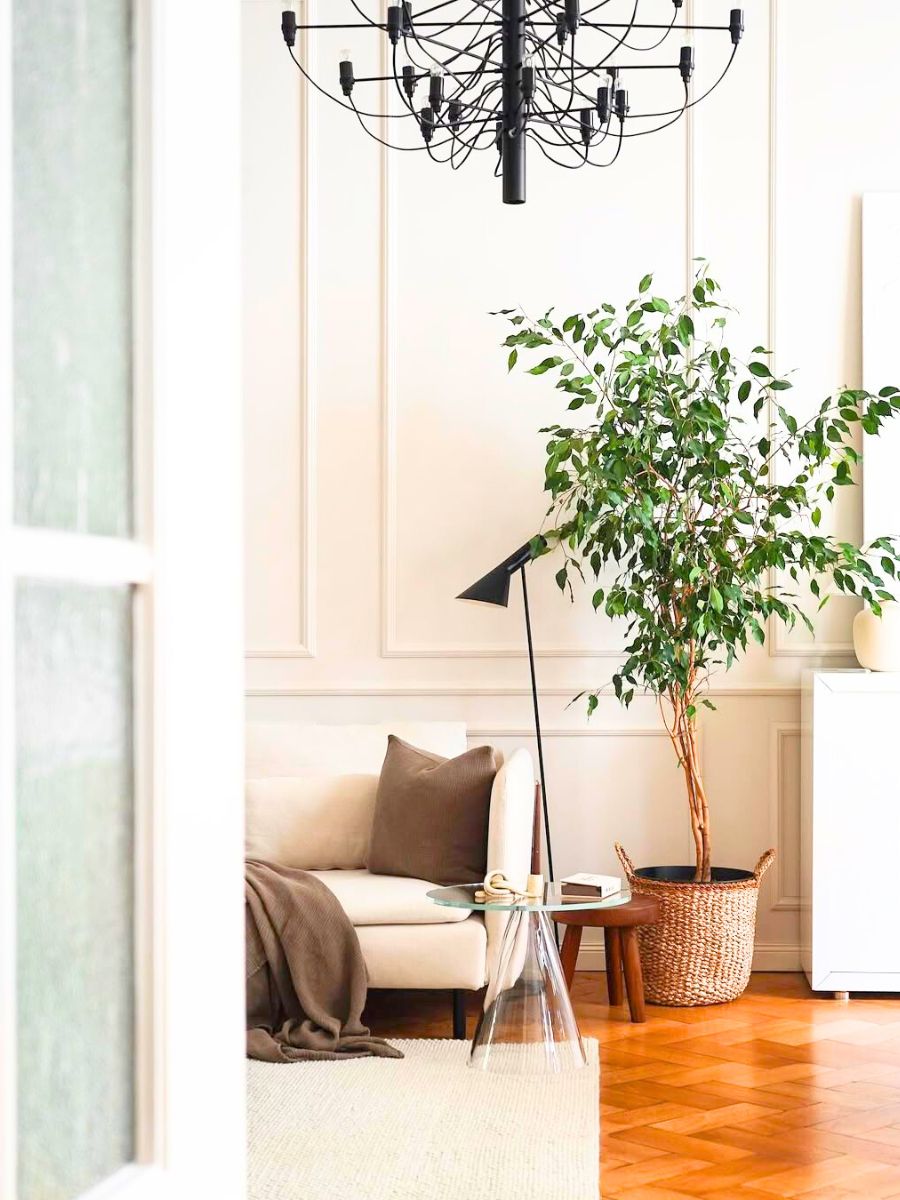 The verdant, cascading leaves of Philodendrons bring organic movement and vibrant life to neutral Japandi interiors. Source: Thursd
The verdant, cascading leaves of Philodendrons bring organic movement and vibrant life to neutral Japandi interiors. Source: Thursd
Care Instructions
Philodendrons thrive with minimal fuss, making them perfect for busy lifestyles. Water when the top inch of soil feels dry. Avoid overwatering, as they prefer dry conditions to soggy roots. Place in well-draining soil to ensure proper airflow.
Fertilize monthly during the growing season, from spring to summer, to promote healthy growth. Keep the humidity moderate to high by misting the leaves occasionally. If the leaves turn yellow, it usually indicates overwatering or insufficient light, so adjust care accordingly.
Placement Tips
Incorporate Philodendrons into well-lit living rooms or offices to enhance your Japandi decor without overwhelming the space. They prefer bright, indirect light, so position them near windows but out of direct sunlight.
For an added aesthetic touch, use neutral-toned or natural-material pots to complement the minimalist design. Hanging baskets or elevated stands can create vertical interest, making use of space in smaller areas without cluttering. These plants can harmoniously blend into various parts of the home while maintaining the serene ambiance hallmark of Japandi style.
Japanese Aralia
Japanese Aralia, known for its broad, glossy leaves, creates a serene atmosphere in Japandi-themed homes. It’s both visually appealing and easy to maintain, making it a popular choice.
 The broad, glossy leaves of Japanese Aralia create dramatic texture in serene Japandi interiors. Source: Guide to Houseplants
The broad, glossy leaves of Japanese Aralia create dramatic texture in serene Japandi interiors. Source: Guide to Houseplants
Care Instructions
Water Japanese Aralia when the top inch of soil dries out. Overwatering leads to root rot, so ensure the soil has proper drainage. Use potting soil rich in organic matter.
Fertilize monthly during spring and summer with a balanced, water-soluble fertilizer. Reduce feeding in fall and skip it in winter. Prune occasionally to maintain its shape and remove yellowing leaves. Keep it in a humid environment; mist the leaves if your home is dry.
Placement Tips
Place Japanese Aralia in well-lit areas away from direct sunlight. Bright, indirect light promotes healthy growth. Ideal spots include living rooms near east or north-facing windows.
Avoid placing it near drafty windows or heating vents, which can stress the plant. Use neutral-toned or ceramic pots to complement the minimalistic Japandi aesthetic. Japanese Aralia pairs well with wooden furniture and natural textiles, enhancing the tranquil vibe of your home.
Bonsai Tree
Bonsai trees are perfect for Japandi-themed homes, blending elegance and tranquility. These miniature trees symbolize harmony and nature, embodying the core principles of Japandi design.
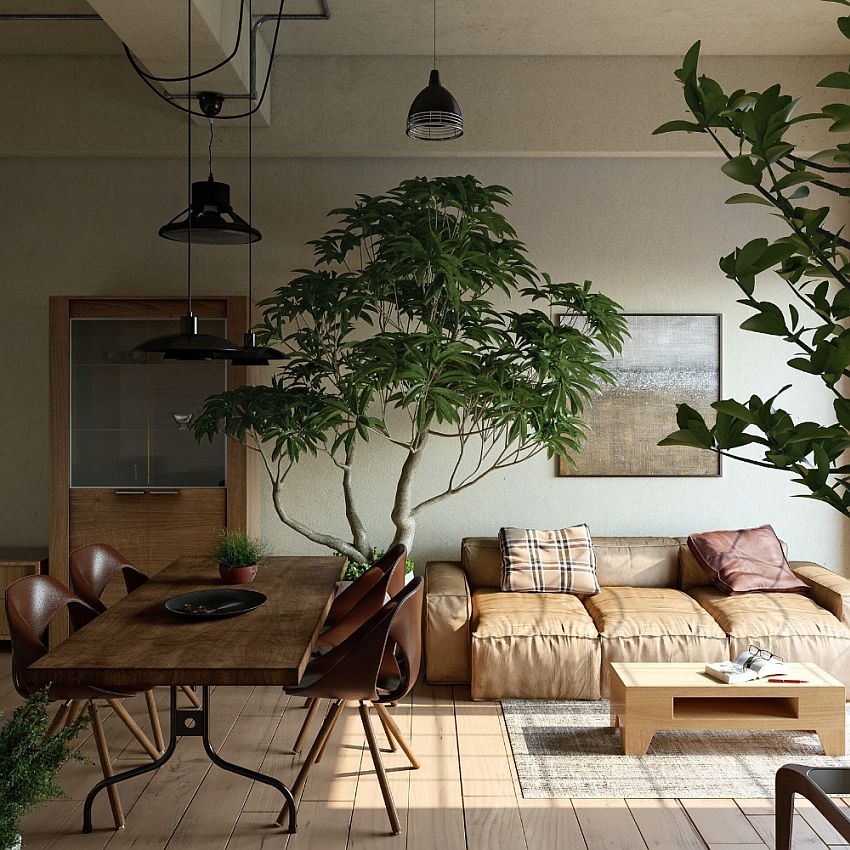 A carefully cultivated bonsai adds traditional Japanese elements to Japandi spaces, embodying the principles of patience and harmony. Source: Homecrux
A carefully cultivated bonsai adds traditional Japanese elements to Japandi spaces, embodying the principles of patience and harmony. Source: Homecrux
Care Instructions
Bonsai trees require consistent care to thrive. Water regularly, keeping the soil moist but not waterlogged. Check the soil daily, especially in small containers that dry out quickly. Prune branches to maintain shape and size. Use sharp, clean tools to avoid plant damage.
Repot every 2-3 years, ensuring fresh soil and root health. Fertilize monthly during the growing season, from early spring to mid-fall, using balanced liquid fertilizer. Avoid fertilizing during dormancy in winter months, when growth slows. Monitor for pests, treating with insecticidal soap if needed. Keep your bonsai in humid environments for optimal growth, misting occasionally to increase humidity.
Placement Tips
Place bonsai trees where they receive indirect sunlight, such as near east or north-facing windows. Avoid direct sunlight, which can scorch leaves, especially during summer months. Ensure good airflow to prevent fungal diseases; avoid drafts from windows and doors. A well-lit spot in the living room, dining room, or even a home office works best.
Use neutral-toned pots to maintain the minimalist Japandi aesthetic, allowing the tree’s natural beauty to shine. Elevate on a shelf or plant stand to highlight its elegance and make care tasks easier. Multiple bonsai arrangements in different sizes can create a serene focal point, enhancing the tranquil ambiance of Japandi-inspired interiors.
Fern
Ferns make a beautiful addition to Japandi design, adding an element of natural elegance with their lush greenery and delicate fronds.
:strip_icc()/CD_18227_6gBMIXmHKku9096TRolpJk-cbceccb8bd864eb6a1eabfbbfccbb957.jpg) The delicate, lacy fronds of ferns add texture and movement to serene Japandi interiors. Source: Better Homes & Gardens
The delicate, lacy fronds of ferns add texture and movement to serene Japandi interiors. Source: Better Homes & Gardens
Care Instructions
Ferns require consistent moisture. Water the fern when the top inch of soil feels dry, ensuring the soil remains moist but not waterlogged. Mist the leaves regularly to maintain humidity levels between 50-80%.
Use well-draining, organic-rich soil and feed monthly with a balanced liquid fertilizer during the growing season. Trim any brown or withered fronds to promote healthy growth. Avoid over-fertilizing, which can lead to salt buildup in the soil.
Placement Tips
Place ferns in areas with indirect sunlight. Ideal spots are near north or east-facing windows. Create a serene atmosphere by situating the fern in a neutral-toned pot to complement the Japandi aesthetic.
Ensure good airflow around the plant to prevent mold growth. Grouping ferns with other houseplants such as peace lilies and pothos can enhance the tranquil ambiance of your home. Avoid direct sunlight, which can cause frond damage.
Eucalyptus
Eucalyptus is the perfect finishing touch for a Japandi-inspired home. Its subtle fragrance and elegant leaves add a refreshing vibe to any space. Whether you choose to display it in a vase or as a potted plant, eucalyptus can effortlessly enhance the serene atmosphere we’re aiming for.
 Fresh or dried eucalyptus stems in a simple vase bring both natural fragrance and sculptural beauty to Japandi interiors. Source: Laura’s Humble Abode
Fresh or dried eucalyptus stems in a simple vase bring both natural fragrance and sculptural beauty to Japandi interiors. Source: Laura’s Humble Abode
By incorporating these houseplant ideas, we’re not just decorating our homes; we’re creating sanctuaries of peace and simplicity. Let’s embrace the Japandi style and let nature’s beauty transform our living spaces into serene havens.